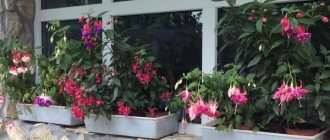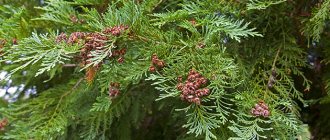Author: Elena N. https://floristics.info/ru/index.php?option=com_contact&view=contact&id=19 Category: Garden plants Published: January 06, 2019Last edits: January 20, 2021
- When to plant
- Growing conditions
- How and when to collect seeds
- Cleome Spinosa
flowers (lat. Cleome), or cleome , belong to the genus of annual or biennial plants of the Cleome family, growing throughout the globe in areas with warm and temperate climates and numbering about 70 species. For the peculiar shape of the inflorescences, the Germans call the cleome flower “spinenpflanze”, which means “spider plant”. Unusual brushes look like an explosion, a splash of champagne - you may not like this plant, but it is impossible not to pay attention to it. The spectacular beauty of the flowers, the strange smell, as well as the fact that the cleome plant blooms all summer from June to September - these qualities are increasingly attracting the attention of flower growers.
Planting and caring for cleome
- Planting: sowing seeds in the ground - before winter or in spring. Sowing seeds for seedlings - at the end of February, planting seedlings in the ground - at the end of May or early June.
- Flowering: from June to September.
- Lighting: bright sunlight.
- Soil: fertile, neutral reaction.
- Watering: only in extreme heat, but plentifully.
- Feeding: once every two weeks with complex mineral fertilizer. It is better to feed weak plants by leaves.
- Reproduction: seed.
- Pests: not damaged.
- Diseases: gray rot.
- Properties: the plant has an unpleasant, not at all floral odor.
Read more about growing cleome below.
When is the best time to plant?
At the time of planting, the seedlings should be 45–60 days old. To this age it is worth adding the period of seed germination - approximately 15–20 days.
The time for sowing cleome depends on the region where the summer cottage is located.
In accordance with climatic conditions, cleome is sown for seedlings at the following times:
- Southern regions - early February.
- The middle zone is the end of February or the beginning of March.
- Siberia, the Urals and the Leningrad region - the last days of March.
Best sowing dates according to the lunar calendar 2019
In accordance with the lunar calendar for 2022, the most favorable days for sowing cleome are:
- February - 17th;
- March - from 10 to 16, 19-20 and 23-24;
- April - 7–8, 11–12, 16–17, 20–21.
Unfavorable days for sowing:
- February 21–28,
- from 1–5 and from 22 to 31 March,
- from 1 to 3 and from 20 to 30 April.
Botanical description
The root system of cleome is powerful, the strong stems are branched, covered with short glandular hairs and reach a height of one and a half meters. The leaves are light green, alternate, in some species covered below with small spines, simple or compound - with entire-edged linear elongated leaflets in the amount of five to seven; the apical leaves are entire and small. Regularly shaped flowers of white, purple, yellow or pink are collected at the tops in racemes; long stamens look like spider legs.
The fruit of cleome is a single-locular, pod-shaped polysperm, up to 3 cm long. Many lovers are puzzled by the not entirely floral aroma of cleome, but in the garden, in the fresh air, it is not noticeable at all, but it repels harmful insects. The fact is that this smell in cleome’s natural habitat areas attracts small bats that pollinate the plant.
Application in the garden
Cleome prickly is suitable for flower beds and looks beautiful against the background of the lawn. Due to its large size, it is suitable for large beds in large gardens, where it can be a centerpiece or background plant. In this case, it is recommended to grow it in groups of a dozen or even several dozen plants (of the same variety). The plant does not cause an overwhelming negative effect (even in the case of varieties with brightly colored flowers).
Since over time the plant turns yellow from below, it is worth planting low species in the foreground so that this defect is not noticeable and does not spoil the overall effect.
Cleome acquires special beauty with good branching (special varieties are used) - then it looks like a flowering spherical shrub.
Cleome is ideal for colorful flower beds in a rustic or romantic style along with plants:
- paniculate phlox;
- Echinacea vulgaris;
- rudbeckia shiny;
- New Belgian aster.
When planted along a fence, they create a beautiful flowering hedge even a meter high. An interesting duo will be created by cleome, growing against a wall or fence, planted in different varieties or next to a joyfully yellow and equally long-blooming sunflower.
More compact and low varieties are suitable for containers. In this form they will become an original accent of a terrace or balcony. Cleome on the balcony and terrace will become the main spectacular decoration. It is better to grow it in large free-standing containers, combining several varieties.
Cleome can also be considered a cut flower, but the specific smell may not be to everyone's taste.
Cleome, despite its high temperature requirements, is a fast-growing species that is easy to grow. Thanks to it, you can create spectacular corners in the garden, on the balcony, and on the terrace.
Growing cleome from seeds
How to sow seeds
Cleome reproduces by seeds. How to grow cleome from seeds? They can be sown directly into the ground in the spring or before winter - in November-December, but it is best to use the seedling method of seed propagation. So, when to sow cleome for seedlings? Cleome has a long growing season, and if you want to collect ripened seeds in the fall, then you need to sow seedlings at the end of February. Before sowing, in order to speed up the process of germination, cleome seeds are soaked for 12 hours in a solution of Zircon or Epin (2 drops of the drug per glass of warm boiled water), then sown in a shallow container with seedling soil (garden mixture, humus and sand in a ratio of 2: 2:1), and sprinkled on top with a 1.5 cm thick layer of the same soil and covered with glass to create a greenhouse effect.
- Don’t throw away rotten potatoes – we’ll get elite tubers from them!
In the photo: How cleome blooms
Seedling care
Cleome does not germinate from seeds quickly, after 2-3 weeks, but after emergence, the seedlings are immediately transferred to a bright windowsill and provided with additional lighting in the evenings. Moistening is carried out as needed - not often, but abundantly, allowing the soil to dry out between waterings.
To prevent root diseases, seedlings are watered once with a weak solution of potassium permanganate.
When the seedlings have a pair of true leaves, they are planted in peat-humus pots, buried in the soil up to the cotyledon leaves. Two weeks after picking, you can feed the seedlings with complex mineral fertilizer in a weak consistency, and then apply fertilizer every two weeks. Rotate the pots from time to time relative to the light source so that the seedlings do not develop one-sided.
How and when to plant cleome seedlings
Picking cleome seedlings is done when the plants have two or three true leaves. You should not delay the procedure for long, otherwise the plants will begin to outgrow, stretch out, competing for sunlight, and their roots may become intertwined in a common box.
It is optimal to choose a new planting container with a volume of about 300-500 milliliters.
A few hours before the event, you should water the plants moderately. And then carefully pick up each seedling separately (with a wooden stick, spatula, fork) and transfer it to a new container. The roots should be placed evenly in the container, without bending. Also, when picking, you need to deepen the seedlings to the cotyledon leaves. After this, you need to carefully compact and spill it generously.
Planting cleome
When to plant
When the return frosts pass, the seedlings can be planted in the ground. Usually the time for planting occurs at the end of May or beginning of June. Select a sunny area without strong drafts for cleome seedlings, and they don’t need anything else, although cleome grows better on fertile soil of a neutral reaction, with good moisture, than on poor dry soil. Therefore, if the soil in the area for cleome leaves much to be desired, add a bucket of rotted compost and two tablespoons of granular flower fertilizer per square meter when digging.
In the photo: Growing cleome in the garden
How to plant
Before planting seedlings, for better rooting in open ground, spray the seedlings with a solution of the Epin-Extra stimulant with cytovit microfertilizer, as indicated in the instructions. Planting cleome in open ground is carried out with peat-humus pots at a distance of 50 to 70 cm between specimens. This is done so that the planting does not thicken, the plants are not affected by pests and diseases, and the flowering is abundant and bright. After planting, water the cleome under the root with a solution of humate.
How to plant hydrangea - practical advice
- Blackleg - 4 conditions, the fulfillment of which will help you forget about this disease on seedlings forever
Transplantation into open ground
As soon as the seedlings get stronger, you can transplant them to a plot in the garden. The time is selected when the weather is consistently warm outside and the recurrent night frosts have passed. This usually happens in late May - early June. Choose a place for planting that is sufficiently lit and protected from drafts. Cleome is not particularly demanding on the composition of the soil, but it is preferable that it be nutritious and have a neutral alkaline environment.
If the soil is depleted, it is first fertilized with special flower additives (2 tablespoons per 1 sq. m) and leaf compost (1 bucket for the same area).
Seedlings are planted directly in pots without removing them (if the planting was in peat boxes or other degradable containers). The bushes are placed at a distance of half a meter from each other. In this way, it is possible to avoid thickening in the future, and flowering will be more spectacular. After completing the planting work, it is necessary to thoroughly water the plants with a humate solution.
Cleome care
Growing conditions
Caring for cleome is simple: water only in hot weather, infrequently, but generously, feed once every two weeks at the roots with complex fertilizers such as Fertika-lux or Fertika-combi, diluting two tablespoons of fertilizer in 10 liters of water. A weak and diseased cleome bush should be fed leaf by leaf by spraying with a solution of one teaspoon of fertilizer in three liters of water. If you can’t wait to see cleome bloom, spray it with Zircon solution before the formation of buds at the rate of 1 ml of the drug per 1 liter of water.
In addition to these manipulations, growing cleome involves removing weeds and loosening the soil if you are too lazy to mulch it after planting.
In the photo: Unblown cleome inflorescence
Pests and diseases
Due to the aroma of cleome, which is far from floral, insect pests do not approach the plant. And it gets sick very rarely, only if you did not plant it close to groundwater and did not water it without any measure, but since this is unlikely to happen, we can assume that cleome is invulnerable.
Pest and disease control
The pungent odor successfully repels pests from cleome and its neighbors. She also hardly suffers from diseases, especially with proper care. And when fungus appears, use fungicides and adjust the watering regime.
Photo: pixabay.com
Monarda (50 photos): types, planting and care in open ground
Cleome after flowering
How and when to collect seeds
Since the cultivation of cleome flowers is carried out exclusively by seeds, it is advisable in the fall, when they ripen, to collect the seeds for sowing before winter or in the spring. You can determine the degree of maturity of the seeds by eye: they are round, up to 1.5 mm in diameter, yellow or brown, depending on the color of the flowers. In order not to miss the moment when the pod bursts and the seeds spill onto the ground, it is better to place several pods in gauze bags, and then the seeds will fall not on the ground, but in them.
In the photo: white cleome
Cleome in winter
Cleome is an annual plant in our climate, so after frost it must be disposed of. In November or December, you can sow the seeds you collected in the fall into the soil to a depth of 1.5 cm and cover the crops with spruce branches, which you will remove with the arrival of spring, so that the seeds that have overwintered in the soil can begin to grow.
Reasons for non-germination of seeds
The main reason for the non-germination of seeds, especially when using last year's planting material, is improper storage. After collection, the grains are dried and placed in ventilated fabric bags and stored in a dark place, protected from moisture and light.
Sprouted seed
Another reason is a lack of nutrients in the soil. That is why it is necessary to properly prepare the site before planting.
And the last reason is excessive moisture, as a result of which the seed can simply rot.
Types and varieties
Only two types of plants have been introduced into culture so far - Hassler's cleome (Cleome Hassleriana) and prickly cleome (Cleome Spinosa) . These two tropical South American species are very similar, differing only in the color of the flowers, so among gardeners, for convenience, it is customary to call both species Cleoma spiny.
Cleome Spinosa
These species are also used to create new varieties and hybrids by crossing. We offer you an introduction to the most popular varieties of cleome prickly:
- Sparaxis: cultivation and care in open ground
In the photo: Cleome Hassleriana
- Hellen Campbell – white cleome;
- Rosakenigin – pale pink cleome;
- Pink Queen and Rose Queen are also varieties with pink flowers;
- Golden Sparkler is a dwarf variety with yellow flowers;
- Giant Pink Cusen - large dark pink flowers;
- Sparkler Lavender - light purple inflorescences;
- Violet Queen is a cleome with inky purple inflorescences.
The most popular variety is the prickly cleome Cherry Queen, up to 60 cm high, with fragrant flowers 2-3 cm in diameter, of an original shape, on long stalks.
In the photo: Cleome Spinosa
Cleome Hassleriana
As for Hassler's cleome, the Champagne Splash variety, bred on the basis of this species, is grown in culture. The height of the variety is 120 cm, white or pink flowers with a diameter of 3-4 cm are collected in an inflorescence-brush up to 20 cm in diameter. Blooms from July until frost.
Cleome is used as a solo plant and in groups with annuals such as lavatera or fragrant tobacco. Due to its high growth, cleome is often grown as the background of a flower garden or hedge.
Features of cultivation
Cactus fruit: description of species and their benefits and harms
In order to grow a healthy, beautiful plant that will delight the eye all season long and decorate the garden or local area, it is important to strictly follow the instructions and observe the principles of cultivation, which include:
- growing seedlings;
- preparing the soil and site for planting;
- feeding bushes;
- regular watering and weeding;
- measures to combat diseases and pests;
- seed collection;
- cleaning or preparing for wintering.
Growing cleome requires observing some nuances.
In order for cleome to grow well, planting and care must be correct. Therefore, each point should be considered in more detail.
Preparing the soil and landing site
For cleome, planting and caring in open ground is a real test. Although the plant is unpretentious, it is difficult to take root in the soil. That is why before planting it is necessary to prepare the place and soil:
- Soil preparation begins several weeks before sowing - in late April-early May.
- For planting, choose a well-lit place away from water drains and drainage pipes, since the cleome plant does not like stagnant moisture.
- The soil needs to be dug up, weeds removed and natural bait added - compost. You can also use complex fertilizers in small concentrations.
Important! Immediately before planting, you need to dig up the soil surface again.
The nuances of growing seedlings
There are the following nuances:
- you need to start sowing seeds for seedlings in March, approximately in the middle;
- for seedlings, containers with a depth of approximately 15 cm are required, since the sprouts have a fairly extensive root system;
- As soil I use a substrate consisting of soil, sand and compost in equal proportions.
flower seedling
The first shoots will appear in 10-15 days. During this period, they need special care: abundant watering, sufficient sunlight and fertilizing.
Note! Sprouted seeds can be treated with a weak solution of potassium permanganate to protect against pests and diseases.
Sowing seeds in the garden
Typically, cleome is grown by vegetative or seedling methods. But they are quite long and require additional effort from gardeners. Therefore, some gardeners prefer to plant seeds in the garden. The plant will be just as big and beautiful, but flowering will come later.
So, one way to propagate the cleome flower is by growing it from seeds, when should you plant them so that they sprout? As soon as the ground thaws, spring frosts will pass. This is at least mid-April.
Note! Seeds usually sprout gradually, one after another. Therefore, you should not immediately replant the sprouts, filling the voids with them. Perhaps the flower is just about to sprout.
Seed sowing technology
Fill the container two-thirds full with the prepared soil mixture. Sow on top of the substrate in increments of 2-3 cm, cover with the substrate. Its layer should be 1.5 cm. Water thoroughly and arrange a transparent shelter.
When using a container with a transparent lid, cover it tightly. When using small containers, secure the conveniently prepared pieces of polyethylene with a rubber band. If you are using a regular box, cover the top with glass. This will help create a greenhouse effect with a warm and humid environment necessary for seedlings to emerge.











